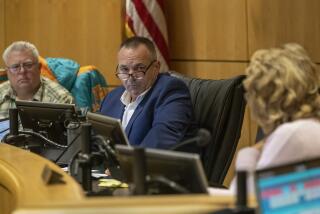Injecting Dose of Calm in Epidemic
- Share via
Hildy Meyers is very cool, very calm. Maybe that’s what going to Harvard and the UC San Francisco Medical School will do for you.
Wanting some shop talk, I went to her office last week in one of the county’s health-care complexes. After all, she’s a medical director in the disease control division and on the front lines of monitoring SARS cases in the county, of which three have been reported.
Does her pulse race faster with talk of a worldwide epidemic? Is this the kind of thing that people in her business live for?
The lady, who comes from a line of doctors, is too reserved to buy into that kind of talk -- and it’s probably a good thing. When it comes to public health issues, you probably want someone who’s not overly excitable.
“When I got my master’s in public health and epidemiology,” Meyers says, “one of the first things a professor said to us was that being an epidemiologist will make you unpopular at cocktail parties, because being an epidemiologist means being a skeptic.”
That is, while others proclaim the latest epidemic to anyone who’ll listen, the epidemiologist sits back and waits for proof. “There are lots of reasons from one person’s point of view that something may appear to be unusual, when it may not be,” she says.
No one denies the SARS threat. What’s unknown, Meyers says, is the extent of the threat and its longevity.
About 270 people in 26 countries have died of severe acute respiratory syndrome. In the U.S., the Centers for Disease Control and Prevention on Friday had identified 39 “probable” SARS cases -- none fatal -- out of the 247 it is checking.
Meyers, 45, discusses SARS with the dispassion of a detective -- which, in a sense, she is. The epidemiologist’s job is to monitor trends -- to investigate, in effect, who and perhaps why certain people get an infectious disease. And, in other cases, how to prevent carriers from spreading one. It’s the kind of work that led in the 1980s to identifying gay men as especially vulnerable to the AIDS virus.
As with a good gumshoe, the disease detective’s work isn’t necessarily flashy. It involves things like checking patients’ occupations, their travel schedules, where they’ve eaten, who they’ve had contact with, what kind of things they’ve been doing. And finding the common threads.
It’s that kind of fact-gathering that appealed to Meyers, when she decided after medical school to veer from the path of hands-on care. And while doctors with patients also can play medical detective, she thought working in public health could benefit a larger number of people.
The job offers the prospect of discovery -- some of it unsettling. “We’ve gone from being somewhat complacent [in the last generation or so] in our ability to deal with infectious diseases to realizing microorganisms continually evolve and are able to escape control,” she says. Advances in antibiotics bred confidence, but new strains have proved the game still is on.
Meyers makes no predictions about SARS, such as whether it could become the first powerhouse medical threat of a new century. “It’s too early to say,” she says. “Maybe we’ll get control of it and the cases will start to go down. Maybe they’ll develop very rapid diagnostic tests, so as soon as someone shows up that might have it, you can detect it and isolate them and control it.”
She concedes darker possibilities.
You’d think those would keep someone on the front lines awake nights.
With complete serenity, however, Meyers says: “Luckily, I don’t seem to be an insomniac.”
*
Dana Parsons’ column appears Wednesdays, Fridays and Sundays. He can be reached at (714) 966-7821, at dana
.parsons@latimes.com or at The Times’ Orange County edition, 1375 Sunflower Ave., Costa Mesa, CA 92626.
.






